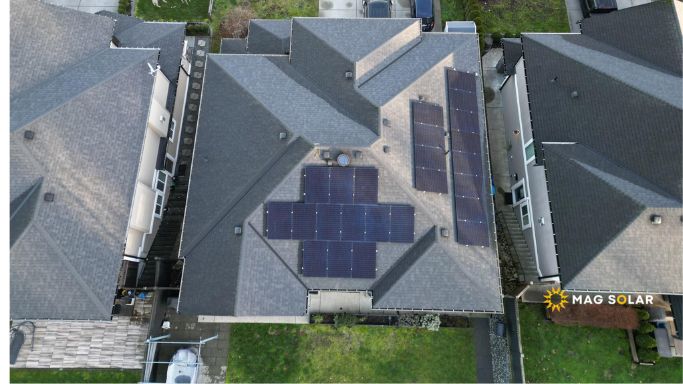Photovoltaic (PV) systems significantly influence the growing global emphasis on renewable energy. However, despite technological advances, PV cells’ long-term performance and efficiency can be considerably hampered by a common yet often overlooked issue: microcracks.
In a large farm or in a residential solar installation, these nearly invisible fractures can reduce panel efficiency and cost money. Understanding the formation, detection, and prevention of microcracks is essential to improving the lifespan and performance of a solar panel system.
What are Microcracks in PV Cells
These are small fissures that develop within the crystalline structure of a cell, often invisible to the naked eye. Although small, microcracks can propagate over time and cause significant disruption to the system’s performance. They normally form during a module’s production or operational lifetime due to mechanical stresses and other external factors.
Formation During Production
During manufacturing, these cells undergo multiple mechanical and thermal processes that can induce stress. For example, cells are subjected to bending, pressure, or sharp temperature gradients that may lead to the generation of microfractures during:
- Wafer slicing
- Mechanical edge isolation
- Cell encapsulation
If not detected and mitigated early, these cracks may grow and cause performance degradation later in the cell’s lifecycle.
Formation During Operation
Once installed, a solar power system is exposed to various environmental factors that can exacerbate microcrack formation. Cracks can form from temperature changes, wind or snow loads, and debris or hail. These cracks can accumulate over time, further reducing cell efficiency.
How Microcracks Interrupt Current Flow
To fully understand its implications, it’s essential to delve into how PV cells work. Photovoltaic cells convert sunlight into direct current (DC) via the photovoltaic effect.
In this process, photons (light particles) hit the solar energy system. Then, they create electron-hole pairs within the cell material. The movement of these electrons generates an electrical current.
Microcracks disrupt this process in two main ways:
| Reduced Conductive Pathways | Creates non-conductive zones to interrupt cell current flow. These cracks prevent electrons from crossing, reducing cell output. |
| Recombination Centres | Making cell defects that act as recombination centres. This means that electrons and holes are meant to generate current instead of recombine, releasing energy in heat rather than electricity. |
Studies using the two-diode model have shown that microcracks lead to a marked increase in the recombination current density (Jo). This means reducing the cell’s short-circuit current (Jsc) and overall efficiency (η).
Cracks in multi-crystalline silicon cells can reduce the minority carrier diffusion length by up to 50%. This can translate to noticeable decreases in power output for large-scale PV installations, even if the cracks only cover a small portion of the cell area.
Maintenance Costs and Downtime in PV Farms and Residential Installations
The long-term effects of microfractures can be financially significant. Reduced power output leads to lower energy production and can increase the levelized cost of electricity (LCOE).
- Extreme cases may require module replacement. This can cause operational downtime and an additional solar panels cost.
- Undetected damages propagating into more significant fractures may necessitate more extensive repairs or replacements of entire modules.
The financial impact might be less severe for residential users, but it is still significant. Reduced efficiency can lengthen the installation’s payback period, which increases overall costs over time.
| Maintenance Costs | Regular monitoring and inspection to detect and repair damages are necessary, but this comes at a cost. Automated systems using techniques such as electroluminescence imaging are essential to identify cracks early before they cause major power losses. |
| Operational Downtime | Maintenance downtime can impact how systems produce solar energy. Downtime can mean a kilowatt-hour (kWh) loss. Hence, leading to reduced revenue. |
Causes of Microcracks
Mechanical Stress
Unit cells are made from brittle materials like silicon and are sensitive to bending or stretching forces.
- Mechanical stress can occur during manufacturing, transport, or installation.
- Once the modules are deployed, external factors such as wind, snow load, or physical impact (e.g., from hail) can induce or propagate microfractures.
Temperature Fluctuations
Another significant cause is temperature fluctuations. PV cells are exposed to considerable temperature differences between day and night or between seasons.
- The differing thermal expansion rates of materials within a module can cause internal stress. This can lead to the formation or propagation of microcracks.
- This phenomenon is particularly relevant in climates with extreme temperature swings, where the thermal cycling between hot and cold conditions puts additional strain on the modules.
Environmental Stress
Environmental factors such as wind loads, hailstorms, and vibrations can also lead to microcrack formation.
- Wind can flex the module over time.
- Impacts from hail or debris can cause localized stress points that eventually lead to microcracks.
- Poor handling during transportation or installation can also contribute to crack formation before the modules are even operational.
Technologies to Detect Microcracks
Electroluminescence (EL) Imaging
EL imaging involves applying a forward bias to the cell and capturing the emitted infrared light using a sensitive camera. Microcracks appear as dark regions in the EL image, which indicates reduced local minority carrier diffusion length and electrical activity in the cracked areas.
- EL imaging provides high spatial resolution and is widely used in research and industry to detect intrinsic and extrinsic defects in PV cells.
- This technique can identify cracks that would go unnoticed in traditional visual inspections.
Infrared (IR) Thermography
Infrared thermography measures the heat distribution across a cell by capturing infrared radiation emitted from the surface.
- Microfractures create localized recombination centres, where electrons and holes recombine and release heat.
- These hot spots can be identified using an IR camera. Allows operators to detect areas with cracks.
Additional methods for microcrack detection include photoluminescence imaging and ultrasound techniques, both of which can provide detailed information about the material integrity.
However, EL imaging and IR thermography are the most commonly used methods due to their efficiency and high resolution. Preventing microfractures requires addressing production processes and operational conditions.
Strategies to Prevent Microcracks
Improved Manufacturing Techniques
For example, using diamond wire saws instead of conventional blades during wafer slicing can reduce mechanical stress. Refining the cell encapsulation process can minimize the potential for mechanical stress during lamination.
Mechanical Design Improvements
Panels should be designed to minimize mechanical stress during both installation and operation. This includes ensuring adequate frame support to prevent excessive flexing due to wind or snow loads. Utilizing materials with better mechanical resilience and ensuring proper transportation and handling can mitigate the formation during deployment.
Temperature Management
- Ensure adequate ventilation to avoid overheating and reduce thermal cycling and temperature-induced stress.
- Select materials with compatible thermal expansion coefficients for module components. They help reduce the internal stress caused by temperature changes.
Routine Monitoring and Maintenance
- By catching cracks in their early stages, operators can replace or repair affected modules before they cause significant efficiency losses.
- Implementing automated monitoring systems for large-scale farms that continuously scan for damages is an effective preventive strategy.

Save Energy Costs and Maximize Longevity With Reliable Solar Panel Installation
Microcracks are a serious concern that can significantly degrade the performance and efficiency of PV systems. Improved manufacturing, EL imaging, and preventive strategies like mechanical design and routine monitoring from top solar companies can reduce damages.
Addressing the challenges is essential to ensuring long-term durability and efficiency for solar energy to truly fulfill its promise as a clean and reliable power source. Repairing and installing solar panels costs a significant amount, so ensure you work with a reliable company like MAG Solar. Our experts install solar panels with high-quality units tailored to your conditions to ensure longevity. Get your solar panel installation today!
Frequently Asked Questions
Are certain types of solar power systems more prone to microcracking than others?
Yes, certain solar system technologies are more prone to microcracking. Due to their grain-boundary structure, multi-crystalline silicon (mc-Si) cells are more susceptible to mechanical stress and cracking than monocrystalline solar panels (mono-Si cells). However, mono-Si cells are not immune to microcracking, especially in harsh environments.
How does a microcrack affect warranty claims for panels?
Microcracks can affect warranty claims depending on the terms set by the manufacturer. Certain warranties cover performance degradation due to manufacturing defects but not improper handling or environmental stress. Reviewing warranty terms and understanding what is covered is essential. This is regardless of whether off-grid or grid-tied solar systems.
Can damages lead to safety hazards, such as electrical shorts or fires?
Yes, in extreme cases, microfractures can pose safety hazards. If a crack propagates and affects the cell’s interconnections or causes localized hotspots, it can lead to overheating. In rare instances, this can result in electrical shorts or fire hazards if the panel’s protective layers fail to prevent thermal runaway.

